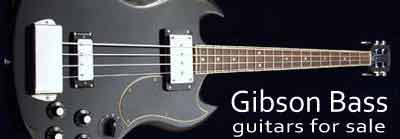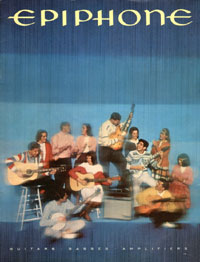• Solid Mahogany body • one-piece mahogany neck • rosewood fretboard with dot inlays • single humbucking pickup • 30 1/2 inch scale.
Model: 1965 Epiphone Newport
Scale: 30 1/2"
Width at Nut: 38.7mm ≈ 1 1/2"
Neck: One piece set mahogany neck. Rosewood fingerboard. Adjustable truss rod. 20 frets.
Body: One piece mahogany body. Width 13" length 17" thickness 1 3/8" overall body length 44".
Weight: 3.26kg
The Epiphone Newport bass guitar, or EB-S, was manufactured between 1961 and 1969; and this example comes from the middle year, 1965. 1964-1966 were the peak years for the Newport (see Epiphone Newport shipping figures), and so, of all the Newport hardware configurations, this is probably the most abundant. In July 1965, the Epiphone Newport had a list price of $240, the same price as the EB-0 in 1965.
The Newport was, of course, based on the Gibson EB0. It's hardware and construction is typical for a mid-sixties Kalamazoo plant bass: mahogany body, mahogany set (glued-in) neck with rosewood fretboard. Hardware pre-1965 was typically nickel plated, moving to chrome-plated post '65. So instruments produced during this transition period often have a mixture of chrome and nickel plated parts, as components were used up. In this example, the majority of parts are chrome plated: EB humbucker (wide cover) situated right up by the neck, bar bridge, and hand rest. The Kluson 538 tuning keys are still nickel-plated. Compare this bass to a similar period Gibson EB-0, fitted with identical hardware.
This combination of woods, pickup and construction give the Newport the same distinctive deep, rich, bass of the Gibson EB-O. Brighter snarlier tones are possible, when played down by the bridge, rather than over the pickup. The short scale and light weight makes for a very playable instrument indeed.

At some point in 1964, Gibson redesigned the Epiphone Newport, giving it a new asymmetrical body and batwing style headstock, in the same vein as the Embassy Deluxe. Most likely this was aimed at putting some clear water between it and the Gibson models produced alongside the Newport: the EB0 and EB3. Compare this bass to one with the older body style here.
The redesigned Newport, despite retaining the same 30 1/2" scale, and 20 frets, is actually around 5" longer than the first version - the overall length is now around 44" - interestingly though, despite the increase in size, this style Newport is lighter than the older style.
The redesigned 'batwing' Epiphone Newport bass was first included in the 1964 Epiphone 'guitars basses amplifiers. catalog
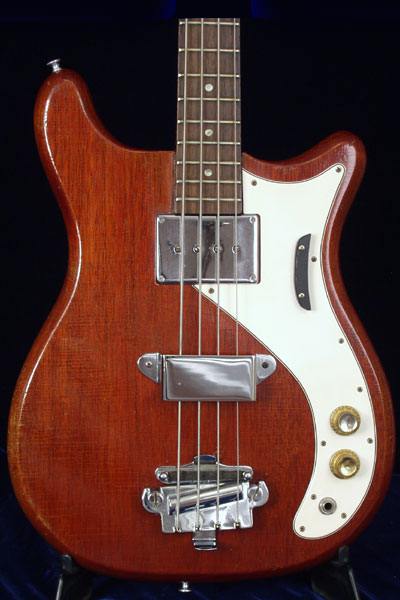
Despite having the same basic hardware, construction and controls as a similar period Gibson EB-0, the Newport has a quite different look - obviously there's the body shape, but a big difference is the new scratchplate: three-ply white/black/white, and now covering a larger area of the guitars front, and with the volume and tone controls, and input jack mounted onto the plate rather than into the body of the guitar itself.
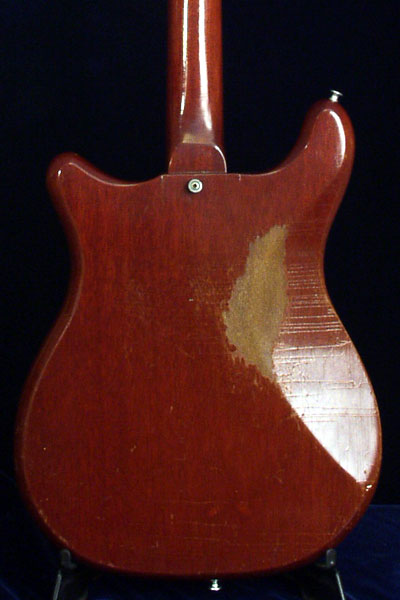
Sixties Kalamazoo-built Gibson and Epiphone solid body basses, all had a set (glued) neck, rather than the bolt-on of Fender basses; typically both body and neck were made of mahogany. This construction, along with the choice of heavily wound humbuckers, gives these basses their distinctive darker tonal qualities.
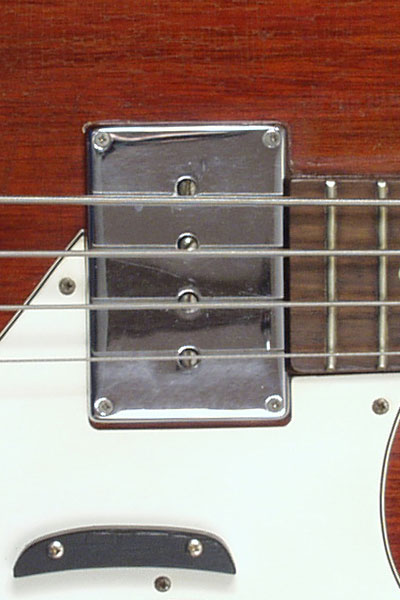
The Newport bass pickup was the same
EB humbucker as installed into other Epiphone and Gibson basses:
Rivoli,
EB0,
EB2 and
EB3. At this stage it had the wide / shallow chrome-plated metal cover. Note also the Ebony finger rest, again a common feature on contemporaneous Gibson and Epiphone basses.
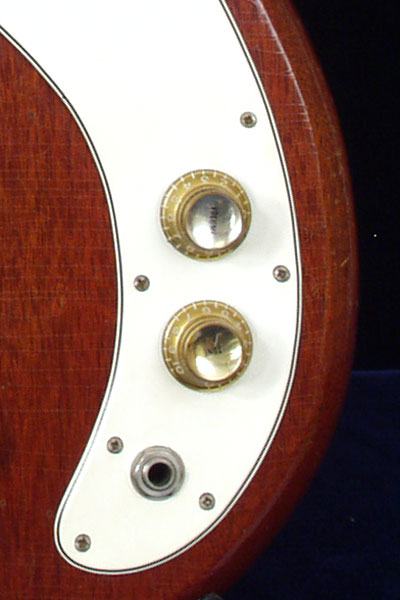
Newport bass controls and and output jack. Controls and input are both scratchplate mounted, for easy assembly. This example is fitted with Gibson gold bell knobs, marked VOLUME and TONE, although many examples were shipped with Epiphone amplifier knobs. Electronically, the Newport is also similar to the EB-0, although there seems to be little consistency in wiring looms around this period - for more on the wiring of this bass, see the
EB0 circuitry page.
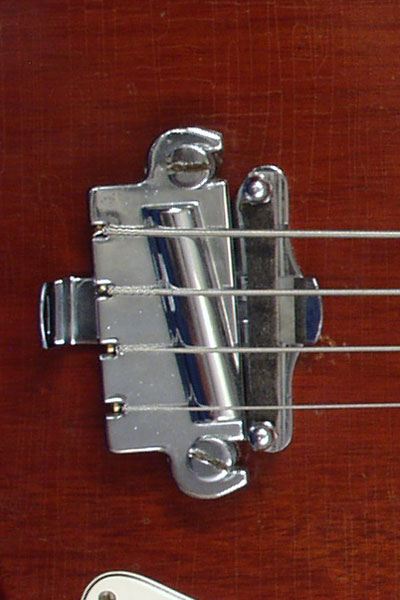
This Newport is fitted with a chrome-plated
bar bridge with
string mute directly below it. The bridge itself is a very simple affair: essentially a single piece of metal with no moving parts; i.e. intonation adjustments were not possible string by string. This design was used until the introduction of the
two-point tune-o-matic circa 1968.
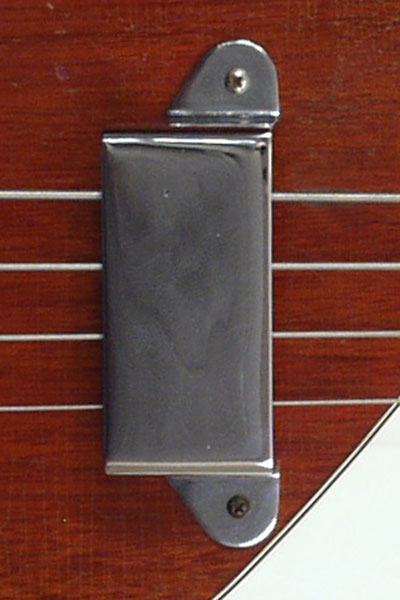
The Newport, like all early/mid 1960s Epiphone and Gibson bass guitars, is fitted with a
hand rest/string cover; now chrome-plated rather than nickel of previous years (compare with a nickel-plated version
here). This part was discontinued shortly after the introduction of the
two-point tuno-o-matic bridge.
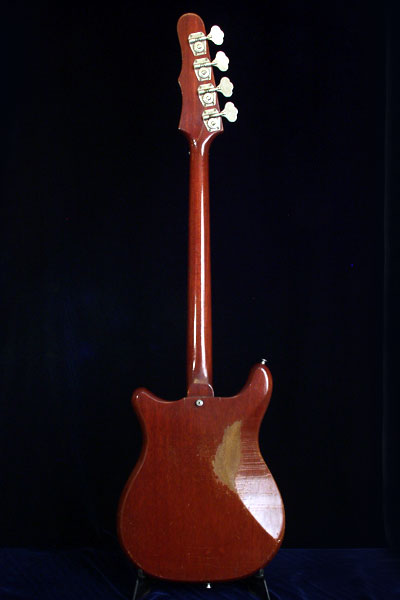
Like all Kalamazoo produced Epiphone basses, the Newport has a set (glued in) neck. The translucent nitrocellulose cherry finish has faded somewhat, and the dark mahogany wood shows through giving the bass an overall brown, rather than cherry colouration. This reverse body view shows the comparative size of the new headstock, against the overall length.
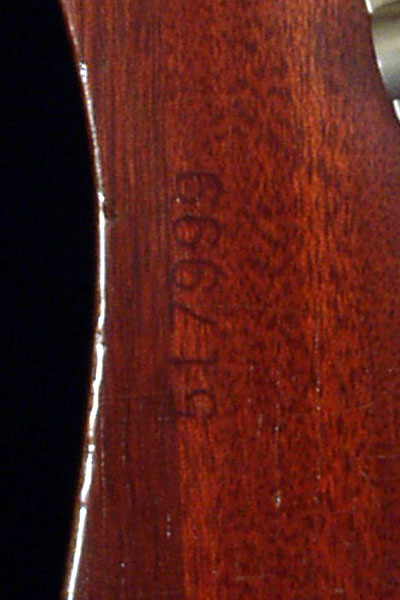
Mid-1960s Gibson and Epiphone instruments use the same sequential serial numbering system - there is no date or other data encoded into the numbers, however Gibson did keep records of serial numbers and shipping dates - in this case, this six digit number starting 5***** suggests a shipping date of 1965.
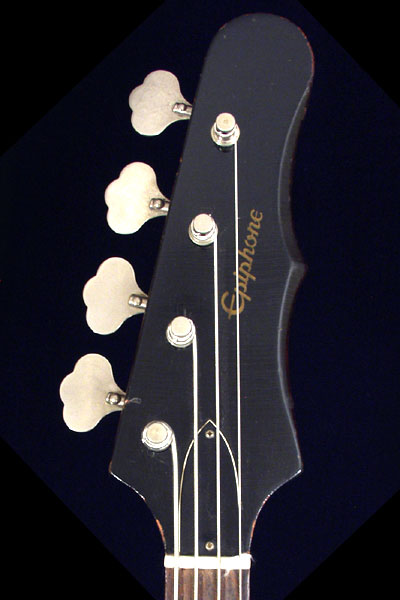
When the Newport was redesigned in 1964, one of the most obvious changes was from a traditional two tuners per side headstock arrangement, so typical of Gibson guitars and basses, to this new 'batwing' shaped four tuners in a row headstock. This was quite a departure from the headstocks of the past, and went a long way towards providing Epiphone solid bodies their own distinctive styling. Note the silk-screened Epiphone logo. and two-ply arched truss rod cover.
The tuning keys are still Kluson 538's.
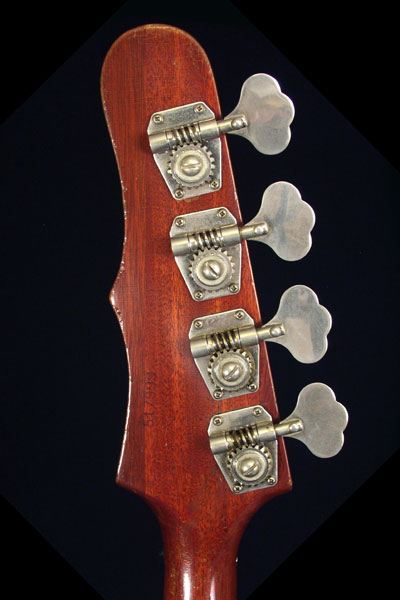
1965 was the year that the Kalamazoo plant replaced nickel with chrome as the plating metal of choice for all it's hardware. There are many instruments produced around this time with a mix of older (nickel) and newer (chrome) parts, and this bass is no exception: the
Kluson 538 tuning keys are nickel-plated, in contrast to the chrome of the bridge, handrest, mute and pickup cover. Compare this headstock with that of a slightly earlier Newport with the two-per-side headstock arrangement
here.
1965 Epiphone Newport sound clip
The Newport has the same construction from the same materials as the EB0 - both basses are characterised by the warmth of rosewood/mahogany and the depth of the super-hot EB neck humbucker:
Epiphone Newport circuitry
As mentioned, the circuitry in the Epiphone Newport is rather similar to that of the EB-0, however not identical. The potentiometers, for example, are scratchplate mounted rather than mounted through the guitar body; this requires pots with shorter shafts. In this case the volume pot is part BA811 3707 (500KΩ), whilst the tone is part BA811 3701 (250KΩ). Both have production code 134 (Centralab), with date codes in the second half of 1965. Read more about Gibson/Epiphone bass pot codes here.
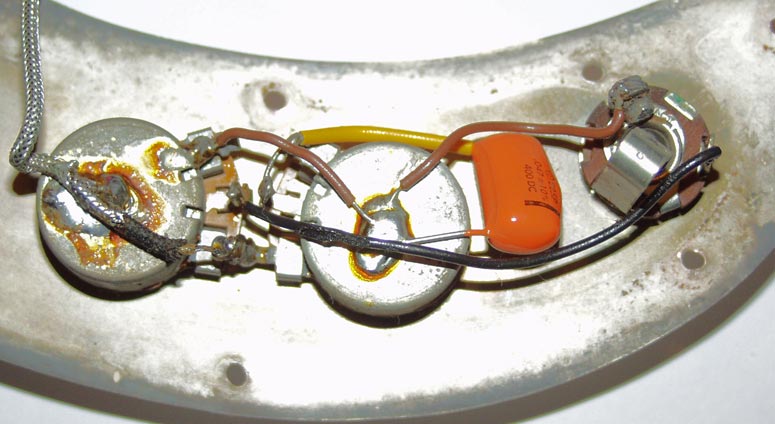
Epiphone Newport bass for sale
Flyguitars.com is funded by its visitors. When you buy through links on our site we may earn an affiliate commission. For more info see
terms and conditions.
Beach City, Ohio, 446**, UNITED STATES OF AMERICA
$1979
Used beautiful in very good condition I have owned this bass for over 40 years in the late 70??s this bass was refinished and refurbished by Virgil Lay founder of Lays guitar repair in Akron Ohio everything that is on this bass was done in 1978 it has many awesome upgrades a Bartolini split coil muddbucker pick up with two 2 position toggle switches a Badass bridge and Grover tuners. Bass is strung with Thomastik flat wound strings plays smooth and flawless very nice action. It??s not perfect ...
more
Springfield, Missouri, 658**, UNITED STATES OF AMERICA
$380
First introduced in the early 1960's, the Epiphone Newport Bass has become a sought-after instrument! This blast from the past features a mahogany body, a mahogany neck and a laurel 20-fret fingerboard. Its vintage shape and short-scale length (30 5") provide both an excellent look and awesome playability. Two humbucking pickups produce bold tone full of warmth and sustain. Controls include master volume, tone and blend. The sunset yellow finish makes the Newport Bass pop!
more














